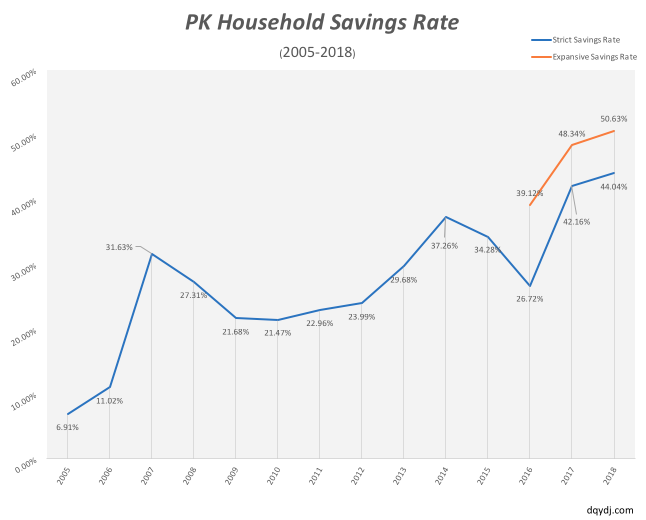Every year, the "blessing" of tax season provides us the "convenient" opportunity to examine our personal financial performance in the previous year.
And what is the most important marker of financial performance? I'm glad you asked - I'd argue it's your savings rate.
The input to this system is, of course, income. From income, there are really only three buckets for every dollar of income:
- Taxes
- Spending
- Savings
When you're staring at documentation on income and taxes, you might as well sum up either spending or savings. If you know three of the four, then you can compute the fourth for free.
In 2018, our family's net after-tax saving rate was 44.0%. Using an expansive savings definition including principal paydowns, our savings rate was 50.6%.
PK Household Savings Rate History

Here's a graph of our savings rate over the last 14 years. We've generally kept the ship pointed in the right direction. (...Ignoring 2016, haha.)
We're generally not fans of the more expansive savings rate. However (speaking of ships), that ship has sailed – most personal finance experts and bloggers use an expansive definition of after-tax savings. For the last three years we've computed both rates.
Why don't you like principal payments in saving rate?
First, to be clear: we lost this argument. When you compute your savings rate, you should include principal paydowns. This means the portion of your student loans, auto loans, property loans, or other installment loans which goes to principal counts as savings on the year.
This is because principal paydown is accretive to net worth: if you pay debt now, you obviously don't owe it anymore.
Our problem was (is) calling that savings.
Take a 6 year car loan, for example. In nearly 100% of cases, you can't resell a car for your purchase price after 6 years. That's 6 years of tracked phantom savings!
Of course, since 2009 or 2011 in the US, real estate is a huge exception – everything is more expensive now. Presumably, after 6 years of mortgage payments you'd more than capture your additional principal if you sold.
So... it's a complicated subject. We have computed a rate using both methodologies for the last few years.
2018: Joining the 50% Savings Rate Club
Those nuanced feelings aside, we were very happy to pass the 50% savings rate point for the first time!
50% is the most important magical breakpoint for savings rates. When you save 50+% in a year, you're banking one year's worth of expenses for a year of spending.
On top of that, high savings rates are deceiving.
The difference between a 75% savings rate and 80% seems tiny. However, a 75% savings rate is the same as saving three years worth of living expenses while an 80% savings rate is four years. Buried in that 5% percentage point difference is an entire year of work!
So, we're very happy to crack 50%. In 2019 we hope to save an even higher percentage of income – especially as (we suspect) the economy is going to slow down a bit. Or... at least not grow as quickly.
We'll have an asset allocation post soon so you can see how we're positioned going into April 2019.
What was your 2018 savings rate (calculated using your favorite method)? Where do you come down on savings rate methodology? What's your 2019 savings rate goal?
